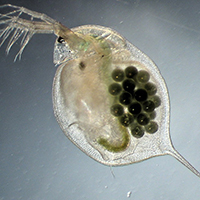Behavioural responses of juvenile Daphnia magna to two organophosphorus insecticides

All claims expressed in this article are solely those of the authors and do not necessarily represent those of their affiliated organizations, or those of the publisher, the editors and the reviewers. Any product that may be evaluated in this article or claim that may be made by its manufacturer is not guaranteed or endorsed by the publisher.
Accepted: 13 September 2021
Authors
In this study, the behaviour of Daphnia magna was studied under equipotent and sub-lethal concentrations of two pesticides congeners: chlorpyrifos (CPF; 5 ng L-1 to 50 ng L-1) and chlorpyrifos-methyl (CPF-m; 30 ng L-1 to 300 ng L-1) with aims to assess and compare the behavioural swimming responses (BSRs) of the cladocerans elicited by both compounds at different concentrations and exposure times. A video tracking analysis after 24 h and 48 h of exposure allowed us to evaluate different behavioural responses (distance moved, average velocity, active time, and average acceleration). The results indicate that BSRs are sensitive indicators of sub-lethal stress. Highly concentration- and time-response changes for both compounds were observed during the experiments. In particular, in the first 24 h of exposure, both compounds elicited a similar decreasing trend in swimming behaviour, in which CPF induced the highest decline. Further, hypoactivity was associated with the narcotic effects of both compounds. Conversely, after 48 h of exposure, we observed an increasing tendency in the swimming parameters, particularly at the highest tested concentrations. However, the compounds did not exhibit the same trend. Rather, CPF-m induced high variations from the control groups. This reversal trend could be due to the activation of compensatory mechanisms, such as feeding, searching, or avoidance behaviours. These results suggest that BSRs are measurable active responses of organisms, which are controlled by time.
Ethics Approval
Ester Eckert, CNR-IRSA Verbania, ItalyHow to Cite

This work is licensed under a Creative Commons Attribution-NonCommercial 4.0 International License.






